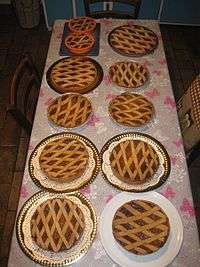Pastiera
|
| |
| Type | Tart |
|---|---|
| Place of origin | Italy |
| Region or state | Naples |
| Main ingredients | flour, sugar, lard, eggs, ricotta, boiled wheat (in milk), water of orange flowers [1] |
|
| |
Pastiera napoletana (pronounced [paˈstjɛːra]) is a type of Neapolitan tart made with cooked wheat, eggs, ricotta cheese, and flavoured with orange flower water.[1][1] It is usually eaten at Easter.[1]
Mythical origins
It was used during the pagan celebrations of the return of the Spring time. During these celebrations Ceres’ priestess brought an egg, symbol of new life in procession. Because of the wheat or the einkorn, mixed with the soft ricotta cheese, it could come from the einkorn bread called "confarreatio", an essential ingredient in the ceremony of the type of ancient Roman weddings named after it "confarreatio". Another hypothesis we may consider is that it comes from ritual bread used, which spread during the period of Constantine the Great. They were made of honey and milk the people offered the catechumen during Easter Eve at the end of the ceremony of baptism.
Origins and tradition


The modern pastiera was probably invented in a Neapolitan convent. An unknown nun wanted that cake, symbol of the Resurrection, to have the perfume of the flowers of the orange trees which grew in the convent’s gardens. She mixed a handful of wheat to the white ricotta cheese, then she added some eggs, symbol of the new life, some water which had the fragrance of the flowers of the spring time, candied citron and aromatic Asian spices.
We know for certain that the nuns of the ancient convent of San Gregorio Armeno were considered to be geniuses in the complex preparation of the Pastiera. They used to prepare a great quantity for the rich families during Easter time.
There are two different ways of preparing pastiera: in the older, the ricotta is mixed with the eggs or with the grain;[1] in the newer, thick pastry cream is added, making the pastiera softer.[2] This innovation was introduced by Starace, a Neapolitan confectioner with a shop in a corner in Piazza Municipio (Town hall square).
The pastiera has to be cooked some days in advance, no later than Maundy Thursday or Good Friday, in order to allow the fragrances to mix properly and result in that unique flavor. The Pastiera is not only cooked but also sold and served in appropriate pans called "ruoti" because it is very fragile, so it would easily crumble up if removed from the "ruoto".
References
Sources
Francesconi, Carola Jeanne (1995). La vera cucina di Napoli (in Italian). Roma: Newton. pp. 258–60. ISBN 8881830213.
External links
| Wikimedia Commons has media related to Pastiera. |